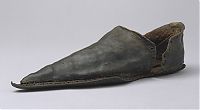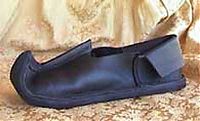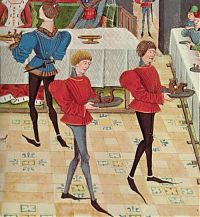The Prescot Street Poulaines
During the evaluation of the Prescot Street site in 2006, one trench was dug that was damp enough to allow the very good preservation of a range of organic materials. A leather shoe vamp ( upper) or Poulaine dating from the late 14th or early 15th century, a leather sole from an adult sized shoe, and 2 bags of leather offcuts identified as being from shoe making were all recovered from the site. The shoes were worn, and were probably thrown away with domestic waste.
The upper has a long pointed toe and is stuffed with moss. It has a low rounded throat with internal binding stitch marks for a reinforcement cord which extends along the top of the upper. There is a fragment of thin strap slotted through the external vamp wing.
The leather offcuts probably arrived on site as rubbish, rather than as part of shoe making or leather working taking place in the immediate area. A leather bag contained 52 small off cuts, clearly waste, and some were identifiable as shoe-making waste. Another bag contains 7 shoe-pieces:a fragment from the toe of a pointed shoe, very similar to the vamp, a sole with a slightly pointed toe and wear on the heel, a worn sole back-part (possibly a clump-or-repair-sole), a fragment of upper, standard narrow rand (a leather strip used to level off sole before the heel is mounted) and a wider welt (narrow strip between upper and sole) or turn welt ( a turnshoe with wide rand as part of the seam – a turnshoe is made inside out then pulled the right way). These are of mixed 15th and 16th century date.
What is a Poulaine and why are they called Poulaines?
The term Poulaine is sometimes used to refer to long-toed shoes in general, while in other sources the term is specifically refer to those shoes whose length was 30% beyond that of the wearer’s foot.
The term Poulaine, as in souliers a la Poulaine, “shoes in the Polish fashion”, referred to the the long pointed beak of the shoe, not the shoe itself. The shoe was referred to as Krakows after the capital city of Poland at that time. The term Poulaine appeared in English by at least 1464 (according the the OED2). Krakow appears in English by c.1367. The points were also referred to as pikes (by 1450) and piggains which may be derived from piggen (a kind of pail with a long handle).
When were they worn?
Shoes with long toes began to be worn in Western Europe during the 12th century. While the pointed toe style remained popular until the 13th century, and never truly faded completely, it maintained a fairly standard length of not exceeding 10% of the foot’s length. The pointed styles were really only worn by the aristocracy and most common people wore round toed shoes.
It is thought that the long toed shoe style didn’t ever die out, but moved gradually eastward in Europe. By the mid-14th century it was “discovered” by western merchants who were trading in the Baltic region. They brought the Poland fashion, or Poulaine toe style back to Western Europe. Eventually, the Church began to complain about the extravagance and implied phallic imagery of the occasionally upturned long stuffed toes, and railed against them as an example of declining morality.
What are their origins?
The origins of these shoes have been, by tradition, placed on the feet of Count Fulk of Anjou, and a need to cover up some sort of foot deformity. Whilst this is possible, there is a continuous tradition of pointy-toed footwear in the Near/Middle East since around 3000 BC (and remains up to today). Count Fulk, or Fulk of Jerusalem , went on Crusade in 1120 and remained in the Middle East until his death in 1143. It is possible that the 12th century Crusaders were influenced by what they saw in the Middle East and the fashions of the east returned to the west with them.
A number of works on the history of costume show pictures for what they refer to as pigases, which seem to find their origins in the mention of pigaciæ and pigatiæ in the contemporary chronicles of 11th and 12th century Normandy and England by Orderic Vitalis , the Historia Ecclesiastiastica, and the purported term pigache in French. These referred to shoes points on them, and specifically the shoes that started appearing at the beginning of the 12th century with long points. But even the longest of these didn’t seem to have points that were more than half again the length of the foot, and and most often reaching no more than two inches beyond the longest toe in the shoe. The longer shoes were stuffed with moss, hair or wool.
How long were the longest-toed fashions?
There is a common misconception that many people in the Middle Ages wore pointed toes so long that they had to tie the ends to their knees in order to walk. There is no evidence apart from a few references. The earliest appears in John Stow’s 1598 ‘The survey of London containing the original, increase, modern estate and government of that city, methodically set down : with a memorial of those famouser acts of charity, which for publick and pious vses have been bestowed by many worshipfull citizens and benefactors : as also all the ancient and modern monuments erected in the churches, not only of those two famous cities, London and Westminster, but (now newly added) four miles compass (p.131)’ where he says:
In Distar Lane, on the North side thereof, is the Cordwainers or Shoemaker’s Hall, which company were made a brotherhood or fraternity in the 11th of Henry IV. Of these Cordwayners I read, that since the fifth of Richard II. (when he took to wife Anne, daughter to Veselaus, King of Boheme), by her example the English people had used piked shoes, tied to their knees with silken laces, or chains of silver or gilt, wherefore in the fourth of Edward IV. it was ordained and proclaimed, that beaks of shoone and boots, should not pass the length of two inches, upon pain of cursing by the clergy, and by Parliament to pay 20 shillings for every pair. And every cordwainer that shod any man or woman on the Sunday, to pay 30 shillings”
As an aside, Act 4 of Edward IV c.7 actually says
Nulle persone Cordewaner ou Cobeler .. face.. ascuns soler galoges ou husend oveqe ascun pike ou poleine qe passera la longuer ou mesure de deux poutz”
Stowes reference was followed in 1614 by William Camden’s ‘Remaines concerning Brittaine: but especially England, and the inhabitants thereof: their languages, names, syrnames, allusions, anagrammes, armories, moneys, empresses, apparell, artillerie, wise speeches, prouerbes, poesies, epitaphs (pp.232-3), where he quotes from the Eulogium historiarum… a monacho quodam malsmburiensi, III, (1362, pp.230-231).
Their shoes, which they call ‘Crakows’, have curved peakes more than a finger in lengths, fastened to the knees with chains of gold and silver, resembling the claws of demons rather than ornaments for human beings. Wearers of such attire ought to be considered players and worthless fellows rather than barons, actors rather than knights, buffoons rather than squires…
However, the original 1362 diatribe that he is printing says instead:
…Their shoes, which they call ‘Crakows’, have curved peakes more than a finger in lengths, resembling the claws of demons rather than ornaments for human beings. Wearers of such attire ought to be considered players and worthless fellows rather than barons, actors rather than knights, buffoons rather than squires…
Unverified anecdotal evidence says there is such a shoe on on a wall painted in Sweden by [Albertus pictor] ( fl c. 1460; d after 1509), and in the illustrations of the Encyclopedie Medieval by Viollet-le-Duc.
Article adapted from Footwear of the Middle Ages © 1996, 1998, 1999, 2000, 2001, 2002, 2003, 2004, 2005 I. Marc Carlson
- Author: Lorna Richardson |
- Nov 01, 2007
- Share




